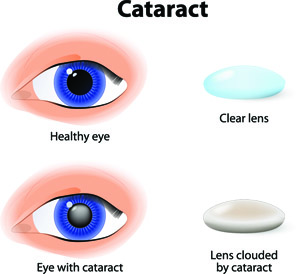Did You Know? Cataracts are the leading cause of vision loss in the United States, and it is the leading cause of blindness in the world.
 A cataract is a clouding of the naturally clear lens of your eye. The lens bends (refracts) light rays that travel into the eye through the pupil and focus onto the retina to produce a sharp image of what we see. The lens should be clear but when it becomes cloudy, the light rays cannot pass easily through it and the image becomes blurry. This clouding normally develops slowly over time and is a part of the normal aging process. However, cataracts can also result from eye injuries, certain diseases such as diabetes, or medications. Genetic factors may also play a role in the development of cataracts.
A cataract is a clouding of the naturally clear lens of your eye. The lens bends (refracts) light rays that travel into the eye through the pupil and focus onto the retina to produce a sharp image of what we see. The lens should be clear but when it becomes cloudy, the light rays cannot pass easily through it and the image becomes blurry. This clouding normally develops slowly over time and is a part of the normal aging process. However, cataracts can also result from eye injuries, certain diseases such as diabetes, or medications. Genetic factors may also play a role in the development of cataracts.
If your vision is only slightly blurry, sometimes a cataract can be treated by simply changing your eyeglass prescription. You should consider surgery when you are not able to see well enough to do the things you want or need to do. Cataracts can only be removed with surgery.
During cataract surgery, the eye surgeon will remove the clouded natural lens in your eye and replace it with an artificial lens. This artificial lens is called an intraocular lens or IOL. A variety of intraocular lenses with different features are available. You will discuss which type of intraocular lens will work best for you with your eye doctor. Insurance companies may not pay for all types of lenses. Intraocular lenses are made of plastic, acrylic or silicone.
Cataract surgery is usually done on an outpatient basis. The entire surgery usually lasts only about 20 minutes. During cataract surgery, your eye surgeon uses local anesthetics to numb the area around your eye but you usually stay awake during the procedure. Your eye will be kept open by a special instrument but you will not be able to see the surgery while it is occurring. A small incision is made in your eye using an operating microscope. The cloudy lens is removed and an intraocular lens implant will be inserted. When the surgery is complete, the doctor will often place a protective shield over your eye.
After surgery, your vision may be blurry at first until your eye heals and adjusts. You will usually see your doctor the day after surgery, the following week, and then again in about a month. You will need to use eye drops as they have been prescribed and your doctor may ask you to wear an eye shield when you sleep during the recovery period. You might have some discomfort for a few days following the surgery. If you need cataract surgery in both eyes, your doctor will schedule the second eye after you’ve healed from the first surgery.
Cataract surgery is one of the safest surgeries performed with 98% of cases occurring with no complications, but like any surgery, it is not without risks. Occasionally, problems might develop, including but not limited to the following: infection; inflammation; swelling; retinal detachment; and posterior capsular haze. You should contact your doctor immediately if you experience any of the above.
Read more about Cataract Surgery.
 Dr. Michael Border is a board certified ophthalmologist with Harrington Physician Services. He sees patients of all ages at our medical office building located at 20 Southbridge Road (Rt. 169) in Charlton.
Dr. Michael Border is a board certified ophthalmologist with Harrington Physician Services. He sees patients of all ages at our medical office building located at 20 Southbridge Road (Rt. 169) in Charlton.
© 2024 UMass Memorial Health